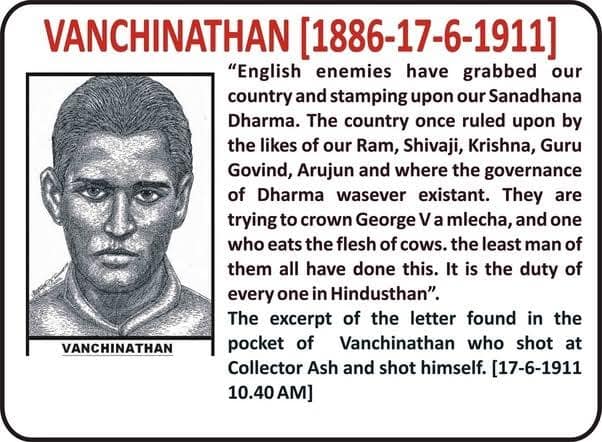
Remembering
#TarakanathDas -
A Krantikari International Scholar in Exile.
Taraknath was born on this day in 1884 at Bengal.
When he was 16, he wrote an essay about Patriotism in a competition and the judge
#Barrister_P_Mitter was highly impressed with the quality..
He ensured

#TarakanathDas -
A Krantikari International Scholar in Exile.
Taraknath was born on this day in 1884 at Bengal.
When he was 16, he wrote an essay about Patriotism in a competition and the judge
#Barrister_P_Mitter was highly impressed with the quality..
He ensured


Taraknath join #AnushilanSamithi for which he was one of the founder.
Similar to celebrating Shivaji Festival at Maharashtra, Taraknath started to celebrate festival of #RajaSitaramRay, a Hindu King who dared the Michaels for years.
In the year 1906, during festival celebrations
Similar to celebrating Shivaji Festival at Maharashtra, Taraknath started to celebrate festival of #RajaSitaramRay, a Hindu King who dared the Michaels for years.
In the year 1906, during festival celebrations
#BhaghaJatin #Taraknath
#ShirishchandraSen #Satyendrasen met and came to an understanding which was kept as a secret.
What they discussed in 1906 was finally revealed by Taraknth himself in 1952 when he came back to Bharat & attended a rally in honour of Bhagha Jatin.

#ShirishchandraSen #Satyendrasen met and came to an understanding which was kept as a secret.
What they discussed in 1906 was finally revealed by Taraknth himself in 1952 when he came back to Bharat & attended a rally in honour of Bhagha Jatin.


Along with specific higher education, they were to acquire military training and knowledge of explosives. They were especially urged to create a climate of sympathy among people of the free Western countries in favour of India's decision to win freedom.
In 1908, at US, he
In 1908, at US, he
started a monthly magazine called Free Hindustan as well as a school for the Indian immigrants that taught English and legal rights. Urged by his mentor Jatindranath Mukherjee (Bagha Jatin), Taraknath joined the Norwich Military Academy in Vermont, U.S., in 1908 to train himself
for armed insurrection in India. However, his plans were aborted when he was expelled for his anti-British activities.
TaraknathDas established India Independence League & later formed #GadharParty along with Nana Hardayal, Pandurang Sadashiv Khankhoje and after 1857 uprising
TaraknathDas established India Independence League & later formed #GadharParty along with Nana Hardayal, Pandurang Sadashiv Khankhoje and after 1857 uprising
this was the first organised attempt against British.
Once the United States entered the 1st World War on the side of Britain, the freedom fighters of Bharat and Germans were arrested and tried in California in 1917. This came to be called the Hindu Conspiracy Case.
Once the United States entered the 1st World War on the side of Britain, the freedom fighters of Bharat and Germans were arrested and tried in California in 1917. This came to be called the Hindu Conspiracy Case.
Taraknath was one of those convicted and served about one and a half years in a federal prison. Upon release, he turned to more peaceful pursuits than the attempt to smuggle arms into India.
Dr. Das belonged to both India and to the U.S. and obtained U.S. citizenship around the


Dr. Das belonged to both India and to the U.S. and obtained U.S. citizenship around the



beginning of the First World War which the U.S. government later tried to take away from him because he was a convicted felon and suspected because of his great hostility to the British Empire. He fought to retain his American citizenship and succeeded.
Like many of the freedom
Like many of the freedom
fighters, even he got fed up with the activities of British Agents Gandhi and Nehru, he turned spiritual in later life like his Guru Aurobindo and concentrated on getting support for freedom from people who had settled outside Bharath.
Tarak was among those who suffered
Tarak was among those who suffered
emotionally from the Partition of India in 1947 and vehemently opposed the process of balkanisation of South Asia till his last day.
He earned a Ph.D. degree from the University of Washington in political science. As one concerned with his two countries, he was particularly
He earned a Ph.D. degree from the University of Washington in political science. As one concerned with his two countries, he was particularly
engaged by the fate of his motherland which for most of his life was ruled by the British.
After Bharat was free, after 46 years in exile, he revisited his motherland Bharath in 1952.
Once here, felt somewhat disillusioned by what he found, and then came back to the U.S. which
After Bharat was free, after 46 years in exile, he revisited his motherland Bharath in 1952.
Once here, felt somewhat disillusioned by what he found, and then came back to the U.S. which
was now his home.
Taraknath Das passed away upon return to the United States on 22 December 1958, aged 74.
#ForgottenHeroes
#VANDEMATARAM

Taraknath Das passed away upon return to the United States on 22 December 1958, aged 74.
#ForgottenHeroes
#VANDEMATARAM


• • •
Missing some Tweet in this thread? You can try to
force a refresh














